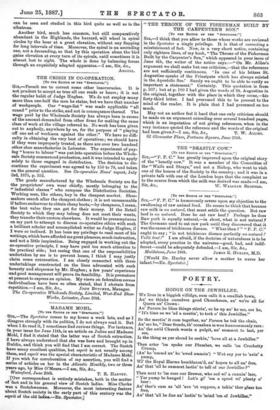THE FLIGHT OF THE ALBATROSS.
ITO TRH EDITOR OW TR. SPECTATOR:1
you allow me to express the surprise with which have read the letter on "The Flight of the Albatross," which appears in your number for June 18th, and which is signed,. "The Writer of the Article P" I recollect some thirty years ago being told by so eminent * natural philosopher as the late Principal James D. Forbes that the flight of birds was to him as a miracle,—that he had no con- ception of the mechanical principles on which it could be- explained.
But great progress has been made since then ; and though the apparatus through which the effect is produced is eminently complicated, and pre-eminently beautiful, there is no longer any doubt of the general principles of mechanical adaptation er which that apparatus is a glorious example.
The natural forces which are concerned are these :—First and foremost, the weight of the bird. No bird is buoyant. Its- weight is the first necessity of its flight. If it were buoyant, it would be as helpless as our stupid balloons. Secondly, there ia the vital energy of its muscular system, enabling it to strike. with more or less force the sustaining and resisting atmosphere, These are the only two natural forces concerned. All the rest is apparatus for the putting of these to a special use. And for this purpose the wings of birds are an apparatus of surpassing ingenuity. Each downward stroke of a bird's wing both sustains- and propels. It sustains, by the reaction of the stroke against the wing-concave, or lower surface of the wing. It propels, in- virtue of the set and of the elastic structure of the feathers. The compressed air escapes backwards. It so escaping, it lifts the elastic tips of the quills, and by a necessary reaction the- body attached to the quills and wings is propelled forward.
Mr. Abbey's explanation is quite correct. It is the potential energy of a bird's weight that enables it to fly when once it haa been lifted above the ground. And it is always lifted above the ground by its own vital energy applied by flapping in the first instance.
This is true of all birds. The albatross is merely an example of extreme perfection and special adaptation. To assign to it a " unique " place, and a special power of " sailing " as dis- tinguished from flying, is a pure delusion. In the scheme oF Nature there are no such unique exceptions to general laws,—no such solitary departures from common plans. The fact that an albatross can fly, and does fly in the teeth of the wind, proves- not that it " sails " like a ship, but that its " sailing " must be absolutely different. No ship can sail in the eye of the wind.
The albatross, although it is a case of extreme development and of special adaptation, is not solitary in this respect. There is another bird, quite common, which is as purely aerial as the albatross. This is the common swift. From morning to night it lives in the air, never resting, and its structure in many respects is like that of the albatross. It will wheel and "sail" for hours, with only a few occasional strokes of the wing. All the phenomena and all the laws of flight, in its highest power, tan be seen and studied in this bird quite as well as in the albatross.
Another bird, much less common, but still comparatively abundant in the Highlands, the buzzard, will wheel in spiral -circles by the hour at a great elevation, without any flapping for long intervals of time. Moreover, the spiral is an ascending one, not a descending, so that by this operation alone the bird -gains elevation at every turn of its spirals, until sometimes it is almost lost to sight. The whole is done by balancing forces through an exquisitely adapted apparatas.—I am, Sir, rtc.,



































 Previous page
Previous page